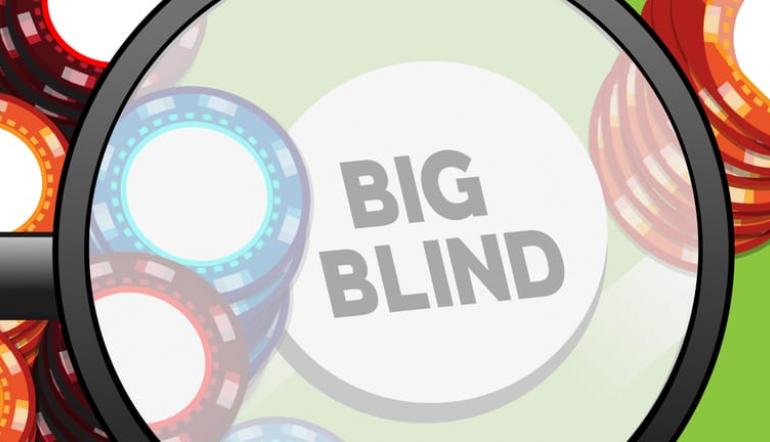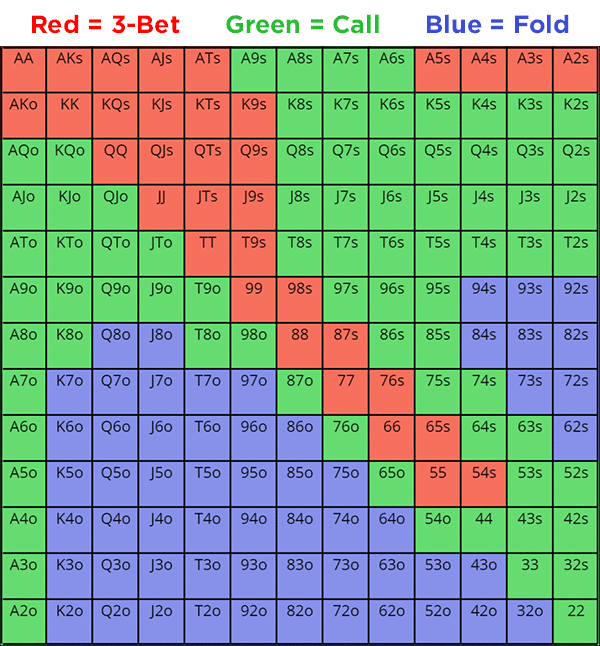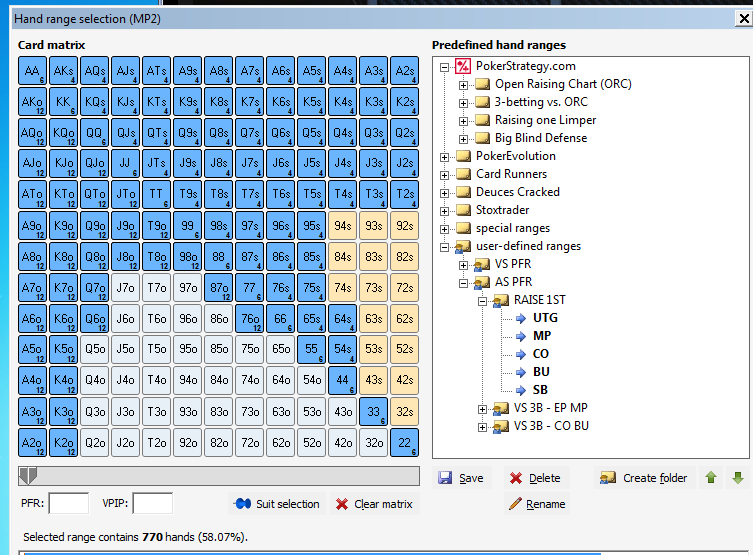Big Blind Defending Range
Opening range charts are a dime a dozen. The aspiring player is usually very familiar with the types of hands that should be open-raised from each position on the 6-max table. What is far more confusing is the struggle that follows when those opening ranges are attacked, namely by the obnoxious 3-bet – a raise so disruptive that it often prevents us from seeing the flop. Our purpose here is to define our opening ranges from the five positions on the 6-max table where it is possible to raise as the first player into the pot, but we shall not be stopping there.
We must learn which groups of hands we should fold, call and raise with after we have opened and faced that dreaded re-raise. Colour coding shall be our friend as we learn when and how to defend our opening ranges.
The Model Situation
The recommended strategies to follow are for use in the same model situation. Assume that we have made an open raise from the relevant position and that it has folded round to the big blind, who has elected to 3-bet. This 3-bet is of a healthy size – around three times a 3BB open or a little larger if our open happened to be smaller than this. We shall be defining how our opening range from the position in question handles this 3-bet. Of course, being in position will help us flat more comfortably, and if out of position we might have to tighten the recommended flatting ranges slightly and look to open a tighter range in the first place wherever we are likely to get bombarded with 3-bets by an in position opponent.
Some players will raise as much as 55% of hands from the button so hands like A4o that were folds versus a tighter opening range are now defends in the big blind. This is because our opponent in late position will now raise hands like K3ss and 22 as well as hands like Q6ss, which instantly makes hands k6o and A3o higher equity defends for us. The range you've described (adding in broadways/big pairs) means you're only defending 35% of hands. So SB could raise any two cards and print money against you. Plus against SB you have a positional advantage to go with your increased pot odds. It is quite difficult to force yourself to defend the big blind with a bad hand, but the reality is that the 6h2h hand in 10% of cases will catch either two pairs or a combo draw on the flop. Defending many hands from the big blind. Even if we are not going to talk much about preflop, I just have to touch this. To have a good understanding of further discussion you need to realize that you should be defending extremely wide from the big blind preflop, even if you are not playing against someone with very high VPIP poker stat. A lot of the time your opponent will be just min. Defending The Big Blind Multiway By Matt Affleck / February 25, 2021 February 25, 2020 One of the biggest mistakes that I see in weak players is that they defend their big blind too wide when facing multiway action.
A Rough Strategy
There are some hands that we shall fold to the 3-bet. After all, a balanced strategy dictates that we should not always defend. If we did, Villain would be able to make far too much money with his strong hands. Similarly, we cannot fold too much, or we make a bluff too profitable an idea for Villain.
We need to 4-bet our very best hands for value, building a large pot while our equity advantage is very high. Wherever there is a value bet, there is a bluff and so we shall use hands that are slightly too weak to call as 4-bet bluffs. This will allow us to defend more hands than we could by only calling or 4-betting for value. In order to make our opponents indifferent to bluffing us and to find an equilibrium against 3-betting, we shall look to protect 45% of our opening ranges in some way. By folding the other 55%, we give Villain some fold equity, but not enough to exploit us.
When it comes to balancing our 4-bets, we may bluff slightly more than we value-raise. This is due to the fantastic strength of our value hands, the playability and blocker value of our bluffs, and the fact that Villain will need a lot of fold equity to shove over our 4-bets lightly with 100BB stacks, provided that we keep our 4-bet between 2x and 2.5x the size of the 3-bet. We can 4-bet and fold 60% of the time to a 5-bet shove without allowing Villain to profit from 5-betting as a bluff. This allows a bluff to value ratio of roughly 1.5 to 1.
A Disclaimer

The following ranges are for use against an aware and aggressive regular, who knows how to apply restrained pressure with 3-bets. There will always be those opponents who are too tight, and against them, we must fold more than the 55% benchmark. On the contrary, there will be those who take the idea of a light 3-bet too far. Against maniacal 3-bet machines, we should fold less than the recommended frequency. The following ranges are nothing but a default guide to protect us against unknown or competent Villains. It is the player’s job to deviate as he or she sees fit if the opposition does not fit this description.

Also note that the opening ranges listed below are slightly on the conservative side. As your skill advantage grows, it will become feasible to widen these slightly and then defend more hands to 3-bets as a direct result.
Colour Coding
In the passive days of early poker, this was much less of an issue. You could call raises pre-flop from just about any position on the table without fear of having to put a ton more money intothe pot thanks to a later position re-raise.

People in those days played straight forward, and if they were re-raising pre-flop, they almost always had the best hand, and you could easily get out of the way or call looking to snap off amonster.
Today’s game is different. Players have learned pre-flop that they can take advantage of weakness and passiveness of other players.
If a loose player opens and you decide to call, a player behind you might elect to 3-bet to put you and the opener in a really tough spot.
The opener will usually have to fold because they have you behind them to worry about and then you are in a tough spot out of position. This becomes even more compounded when we’re in the smallblind.
If the button opens and we just call out of the small blind, the big blind is going to have a lot of incentive to 3-bet a wider range to get rid of the button who is most likely stealing and thenplay a bloated pot in position against you.
You might be saying:

“Well, what if I have a big hand in the small blind? Aren’t they worried about that?”
What would you have done if you had aces in the small blind? You probably would have 3-bet yourself which is what you would have done with every strong hand you have.
This means the big blind KNOWS that you have a marginal hand at best. Yes, as an aside, you can call in the small blind to trap and induce this, but that’s again a discussion for another day.
Big Blind Defending Range Rover Sport
This is why calling and defending with more marginal hands in the big blind becomes so much more appealing. There is no one to act behind you that can potentially squeeze you out or exploit yourweaker range.
Also, it’s always possible from other positions that a player behind you actually does have a stronger hand that warrants a re-raise.
This can’t happen to you from the big blind because you are closing the action. It might not seem like a big deal if you play in weaker games that are more passive.
Big Blind Defending Range Definition
Once you step up to playing with higher skilled or more aggressive players, this is going to create issues for you.